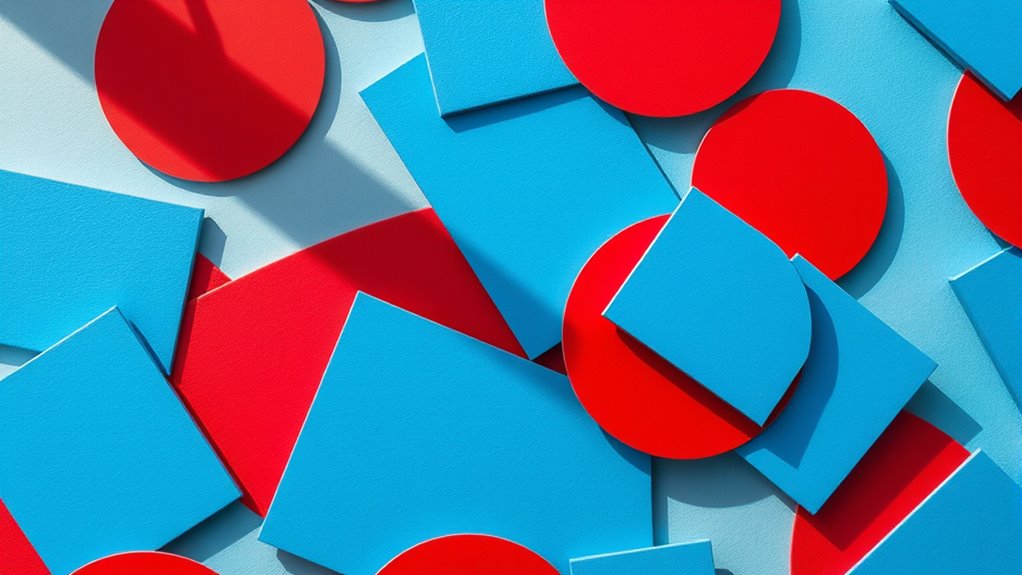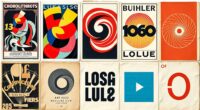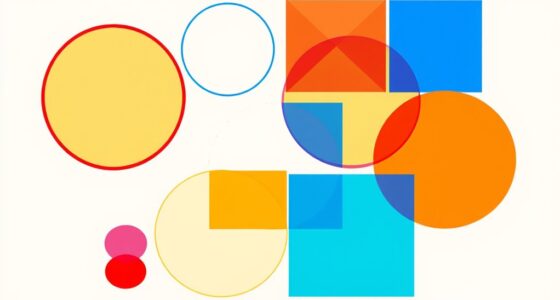Shapes in visual communication influence how you feel and respond. Circles and ovals feel inviting and harmonious, while squares and rectangles suggest stability and dependability. Triangles add energy and direction, with sharp angles conveying urgency and caution. Curved lines evoke comfort, and irregular shapes grab attention. Cultural meanings vary, affecting perception. Mastering shape psychology can help you craft more effective messages—continue exploring to discover how shape choices can shape reactions and trust in your designs.
Key Takeaways
- Shapes evoke emotional responses; circles promote harmony and safety, while sharp angles create urgency and tension.
- Triangles convey direction, movement, and stability, influencing perceptions of growth or stability depending on orientation.
- Rounded shapes foster approachability and trust, whereas angular shapes are associated with strength and professionalism.
- Cultural interpretations of shapes affect their psychological impact, with meanings like unity, stability, or change varying across cultures.
- Consistent use of specific shapes in branding reinforces emotional connection, credibility, and overall brand perception.
The Impact of Circles and Ovals on Perception
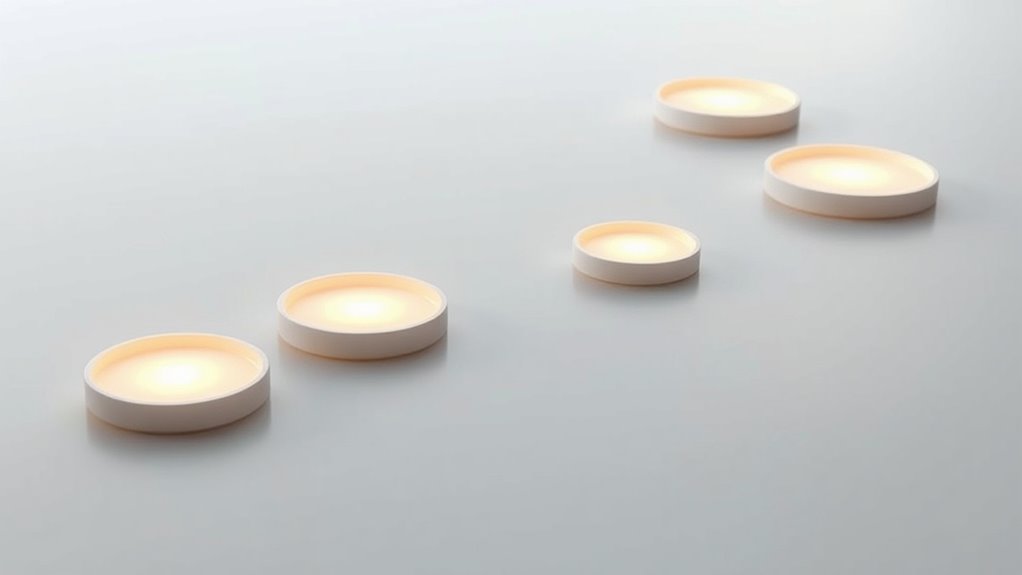
Circles and ovals have a powerful influence on how we perceive objects and spaces around us. These shapes evoke feelings of harmony, softness, and approachability. Because they lack sharp angles, they tend to appear more inviting and less aggressive than other shapes. When you see a circle or oval, you might instinctively associate it with unity, completeness, and continuity. These shapes often suggest movement or flow, guiding your eye smoothly across a design. They can also create a sense of balance and stability, making viewers feel comfortable and at ease. Additionally, the diverse genres of animated movies and their emotional depth demonstrate how visual shapes and storytelling can work together to evoke specific feelings in audiences. Understanding the psychological impact of these shapes can help designers craft more effective visual communication that resonates on an emotional level. Recognizing the influence of visual perception can further enhance how designers use these shapes to shape viewer responses. Incorporating shape psychology into design principles allows for more intentional emotional engagement with viewers. Moreover, familiarity with dog breed characteristics, such as those found in breeds like Labradoodles and Huskies, can inform how visual shapes might be used to represent breed-specific traits in branding or design.
How Squares and Rectangles Convey Stability and Strength

Squares and rectangles are often associated with stability and strength because their straight lines and right angles create a sense of order and reliability. These shapes evoke feelings of dependability, structure, and resilience. Their balanced proportions and geometric precision communicate control and durability, making them ideal for conveying trustworthiness. Additionally, their visual impact reinforces perceptions of solidity and permanence. The inherent symmetry of these shapes also contributes to their perceived stability, making them a popular choice in design elements aimed at reassurance and confidence. Their ability to evoke a sense of security stems from their consistent and predictable form, which naturally appeals to human perceptions of stability. Moreover, the geometric nature of squares and rectangles often symbolizes order and rationality, further emphasizing their association with stability. Recognizing the influence of creative practice can help designers intentionally incorporate these shapes to strengthen visual messages.
The Psychological Significance of Triangles in Design
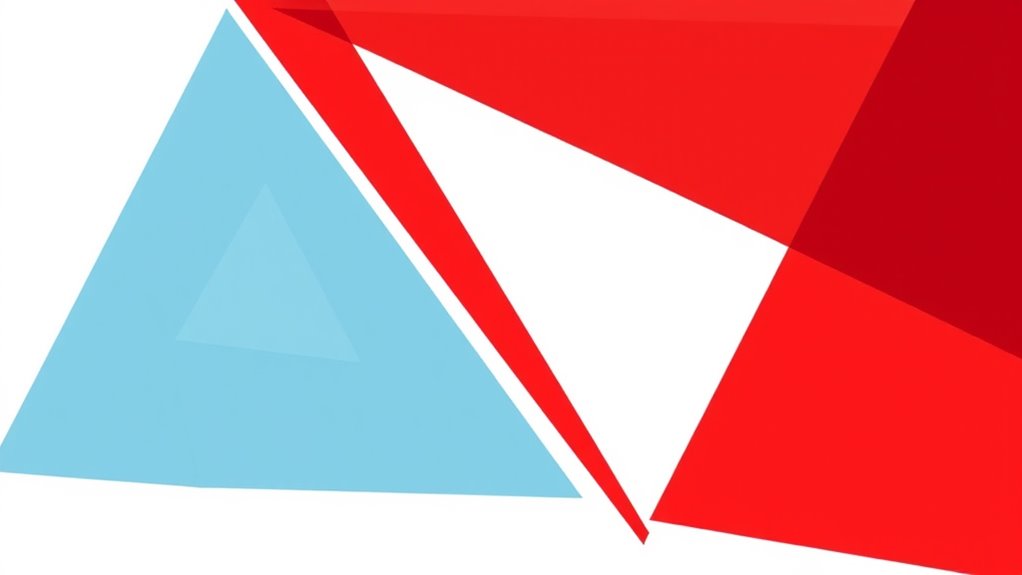
Triangles in design create a sense of direction and movement that draws the eye. They also convey stability when aligned properly, balancing dynamic energy with firmness. Additionally, triangles carry symbolic meanings, often representing change, power, or harmony, influencing how viewers interpret your message. Recognizing the Relationship Dynamics conveyed through shapes can deepen the impact of your visual communication. Practicing Stillness can also help designers enhance their focus and clarity when working with visual elements. Being aware of psychological associations can further refine the effectiveness of your design choices. Incorporating visual harmony through shape selection can optimize the viewer’s emotional response.
Directional Energy and Movement
Triangles inherently direct the eye and influence how viewers perceive movement within a design. Their pointed angles guide your gaze along specific paths, creating a sense of direction and energy. An upward-pointing triangle suggests growth, ambition, and forward momentum, while a downward-pointing triangle can evoke stability or tension. When positioned dynamically, triangles can create a feeling of action, urgency, or progress. You’ll notice that the sharp lines and angles can energize a composition, leading your eye quickly from one point to another. This sense of movement keeps viewers engaged and directs their focus precisely where you want it. By leveraging the directional energy of triangles, you can craft designs that feel lively, purposeful, and compelling. Utilizing visual weight effectively in visual communication can also enhance the clarity and impact of your message, guiding viewers’ perceptions just as shapes do in visual design. Additionally, understanding how hackathons foster collaboration and innovation can inspire creative approaches to visual storytelling.
Sense of Stability
While the pointed angles of triangles create a sense of direction and energy, their stable base can also evoke feelings of security and balance. This duality makes triangles powerful in design, as they communicate movement while grounding the viewer. The base provides a foundation of stability, reassuring you that the structure is solid. Consider the table below, which highlights how the base influences perception:
| Aspect | Effect on Stability |
|---|---|
| Wide Base | Enhances feelings of security |
| Narrow Base | Creates tension, less stability |
| Symmetrical Base | Reinforces balance and harmony |
Symbolic Meanings and Associations
Have you ever wondered why triangles often evoke strong emotional responses in design? Triangles carry rich symbolic meanings and associations that influence how you perceive a message. An upward-pointing triangle suggests stability, power, and aspiration, often representing growth or ambition. Conversely, a downward triangle can evoke feelings of instability or vulnerability, sometimes symbolizing femininity or receptivity. Equilateral triangles symbolize balance and harmony, while sharp angles may evoke tension or dynamism. Cultural contexts also shape these associations; for example, triangles can represent spirituality, strength, or conflict depending on their placement and orientation. By understanding these symbolic meanings, you can harness triangles to evoke specific emotions, reinforce messages, or create visual interest in your designs. These associations make triangles powerful tools in visual communication.
The Role of Sharp Angles in Communicating Urgency and Caution
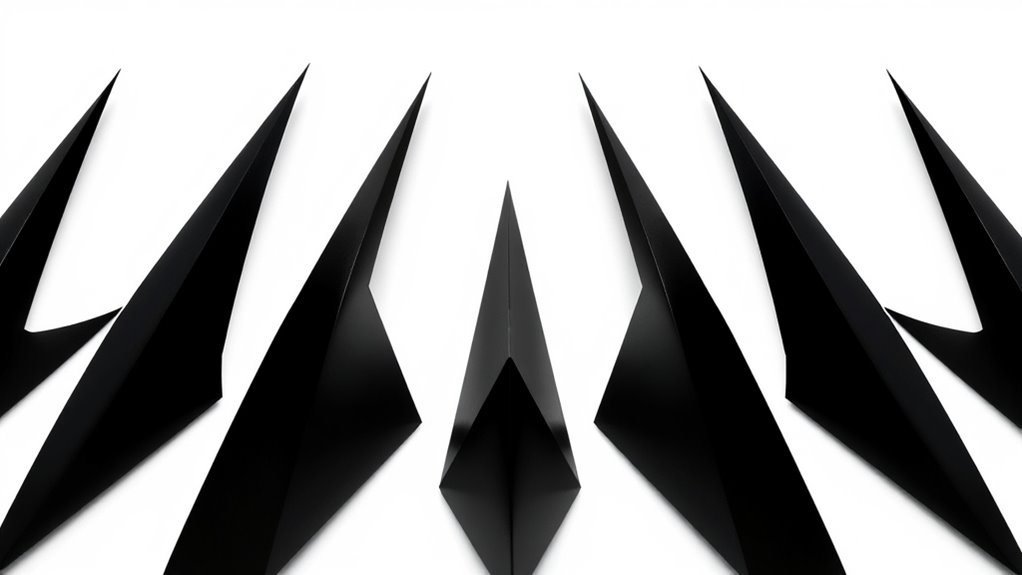
Sharp angles naturally draw your eye and evoke a sense of immediacy, making them effective tools for communicating urgency and caution. When you see pointed edges or angular shapes, your subconscious interprets them as signals to pay attention or proceed carefully. These shapes often trigger a sense of alertness, warning you of potential danger or the need for swift action. Designers use sharp angles in signs, warnings, and alerts to quickly grab your focus and convey importance. Their pointed nature suggests movement and tension, amplifying the message of caution. By incorporating sharp angles, visual communication becomes more impactful, ensuring you don’t overlook critical information that requires your immediate response or careful consideration.
The Soothing Effect of Curved Lines and Rounded Shapes
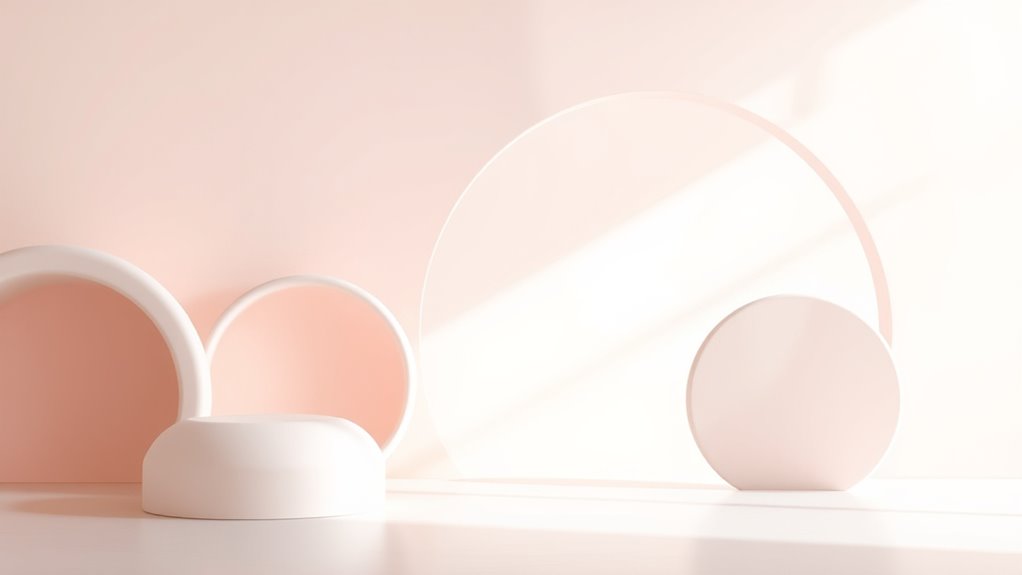
Ever wonder why certain designs feel calming or welcoming? It’s because curved lines and rounded shapes naturally evoke feelings of safety and comfort. Your brain associates these smooth contours with softness, warmth, and friendliness, reducing tension and promoting relaxation. Unlike sharp angles, which can seem aggressive or alarming, rounded shapes create a sense of harmony and flow. They guide your eye gently across a design, making the experience feel effortless and soothing. You’ll notice these shapes often appear in logos, interiors, and product designs aimed at creating trust and approachability. By incorporating curves, designers tap into your subconscious desire for comfort, making visuals more inviting and emotionally soothing. Rounded shapes subtly influence your mood, fostering positive associations without you even realizing it.
How Asymmetry and Irregular Shapes Influence Attention
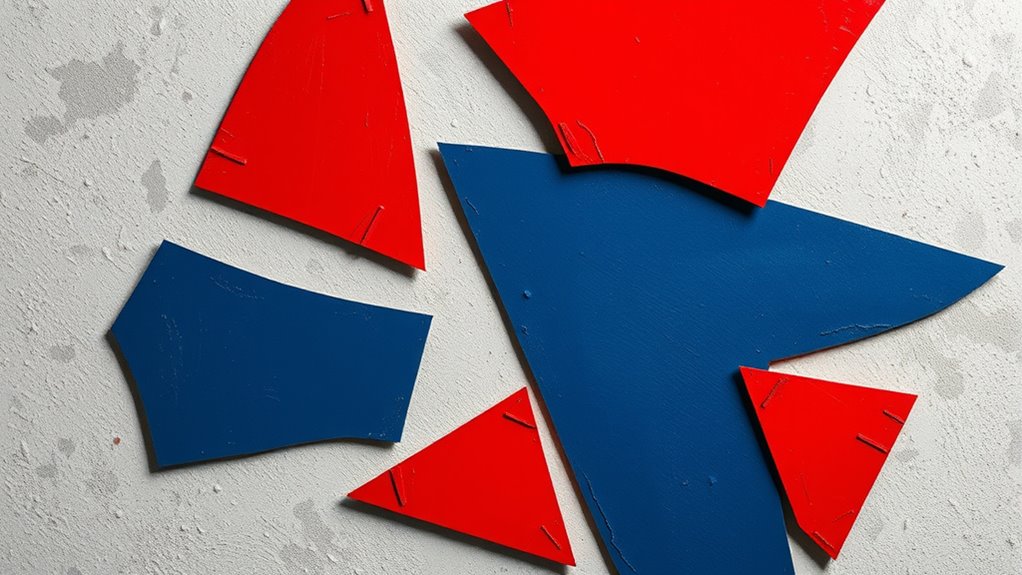
Asymmetry and irregular shapes naturally draw your attention because they stand out from the predictable patterns your brain expects. These shapes break the symmetry and create visual interest, making you focus more. Your eyes are attracted to unexpected forms because they signal novelty or importance. Here’s a quick illustration:
| Shape Type | Effect on Attention | Example |
|---|---|---|
| Asymmetric | Creates focal points, increases curiosity | Abstract art pieces |
| Irregular | Sparks intrigue, guides exploration | Organic, uneven designs |
| Symmetrical | Feels balanced, less attention-grabbing | Classic logos |
This contrast prompts your brain to analyze irregular and asymmetric shapes more deeply, heightening engagement and curiosity.
Cultural Interpretations of Shape Symbolism
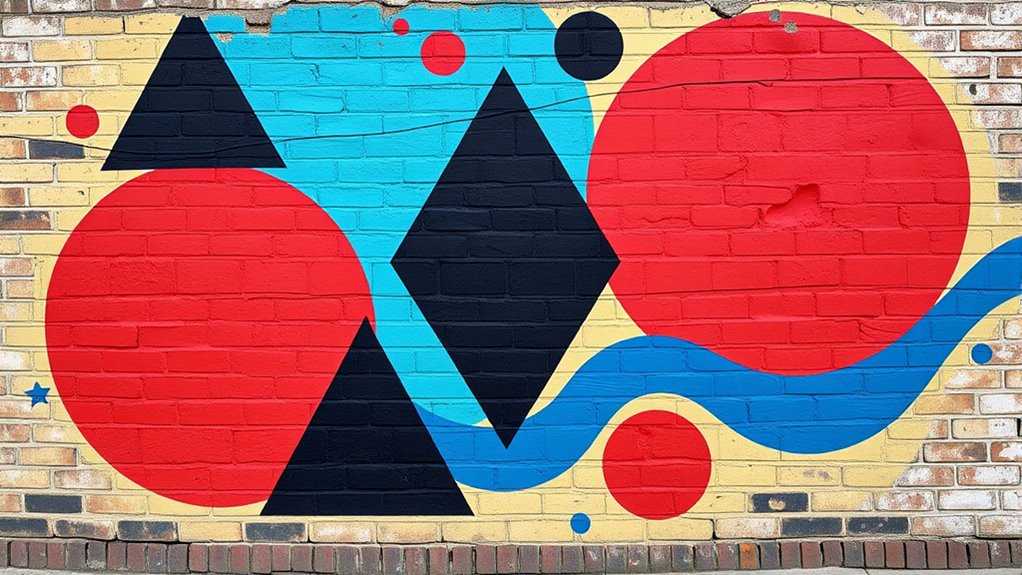
Shapes carry rich cultural meanings that vary across societies, influencing how you interpret and respond to visual designs. For example, in many Western cultures, circles symbolize unity and infinity, while in some Asian cultures, they represent harmony and balance. Squares often denote stability and order, but in certain indigenous traditions, they can symbolize the earth or the material world. Triangles may signify strength or change, depending on their orientation and cultural context. These associations shape your emotional reactions and perceptions without you always realizing it. Understanding these cultural interpretations helps you design visuals that resonate more deeply with diverse audiences. Recognizing that shape symbolism isn’t universal allows you to craft messages that are both meaningful and respectful of different cultural perspectives.
The Influence of Shape on Brand Identity and Consumer Trust
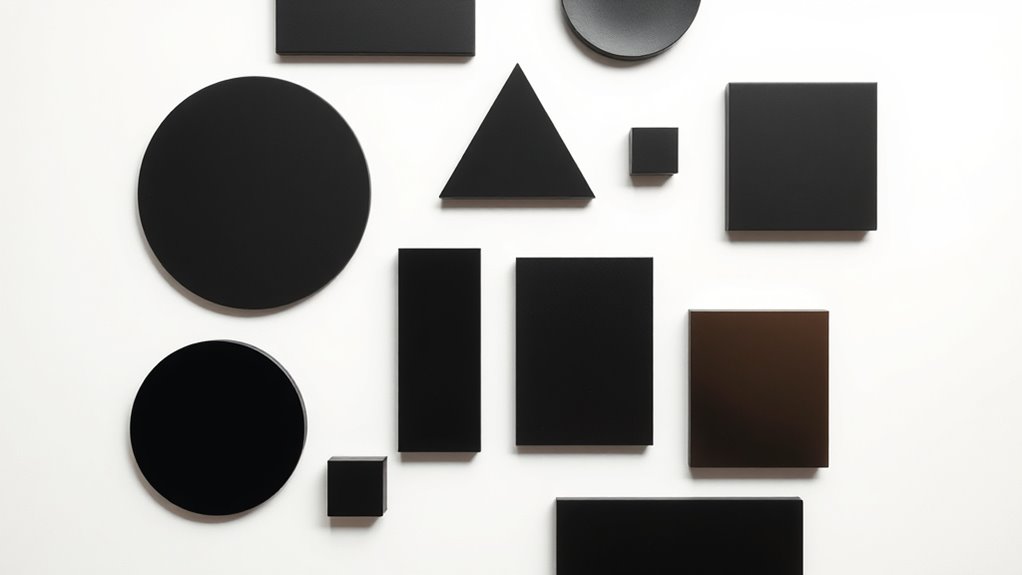
The symbols and meanings attached to different shapes substantially influence how brands are perceived and trusted by consumers. When you see a logo with sharp, angular shapes, you might associate it with strength, stability, or professionalism, making you more confident in the brand’s reliability. Conversely, rounded shapes tend to evoke feelings of friendliness, approachability, and warmth, fostering trust and a positive emotional connection. The consistency of these shapes across branding materials reinforces your perception of the brand’s identity. You’re more likely to trust a brand that aligns its visual shapes with its core values and message. In this way, shape choices directly impact your perception of credibility, quality, and the overall trustworthiness of a brand.
Practical Applications: Using Shapes to Elicit Emotional Responses
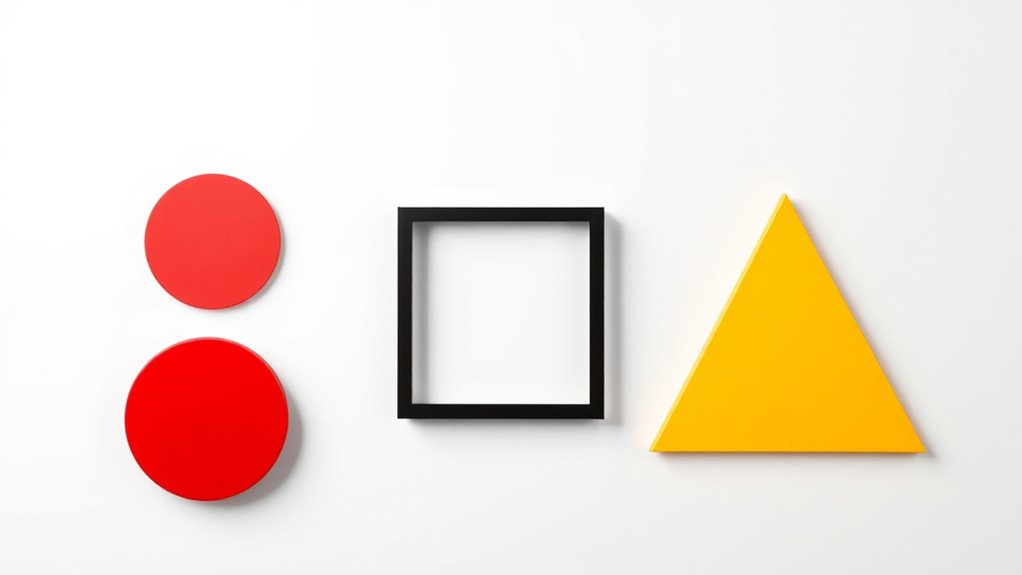
You can use shapes to influence how people feel about your brand or product. For example, round shapes often create a sense of warmth and friendliness, while sharp angles convey strength or urgency. Combining shapes with colors amplifies these emotional effects, making your message even more impactful.
Shape and Mood
Understanding how shapes influence emotions allows you to craft visuals that evoke specific moods. Circles and ovals create a sense of warmth, friendliness, and comfort, making them ideal for brands aiming to appear approachable. Squares and rectangles convey stability, order, and reliability, fostering trust and professionalism. Triangles can evoke dynamism and energy; upward-pointing triangles suggest aspiration, while downward ones may evoke stability or caution. Sharp, jagged shapes often evoke excitement or aggression, whereas smooth, flowing lines promote calmness and relaxation. By selecting the right shapes, you can influence how viewers feel about your message or brand. Using shape intentionally helps you communicate mood effectively, guiding emotional responses without relying on words. Mastering this connection enhances your ability to design impactful, emotionally resonant visuals.
Color-Shape Combinations
Combining colors with specific shapes can considerably enhance the emotional impact of your visuals. Bright, warm colors like red and orange paired with sharp, angular shapes evoke energy, excitement, and urgency. Conversely, cool colors such as blue and green combined with smooth, rounded shapes create feelings of calm, trust, and stability. Using contrasting colors with bold shapes captures attention and stimulates emotional responses. Soft pastel hues with gentle curves generate a sense of comfort and friendliness. You can strategically select color-shape combinations to align with your desired message or brand personality. Remember, the right pairing amplifies your visual’s message, making it more compelling and memorable. By understanding these dynamics, you can craft visuals that resonate emotionally and influence viewer perceptions effectively.
Frequently Asked Questions
How Do Cultural Differences Affect Shape Perception in Design?
Cultural differences profoundly influence how you perceive shapes in design. You might associate circles with unity or eternity in some cultures, while others see them as symbols of perfection or the divine. In certain societies, sharp angles could evoke aggression or caution, whereas in others, they’re seen as dynamic and innovative. Understanding these cultural nuances helps you create designs that resonate effectively across diverse audiences, ensuring your message is both meaningful and respectful.
Can Shape Psychology Influence Consumer Decision-Making Subconsciously?
You might not realize it, but shape psychology can subtly influence your decisions. When you see rounded shapes, you often feel comforted or reassured, making you more likely to trust a brand. Sharp angles can evoke excitement or caution, affecting your perception of products or logos. These subconscious cues guide your choices without you even noticing, shaping your preferences and behaviors in ways that feel natural and intuitive.
What Shapes Are Most Effective for Digital Versus Print Media?
You want to know which shapes work best for digital and print media. Squares and rectangles catch the eye with their stability and structure online, making them ideal for digital interfaces. Circles and organic shapes grab attention in print, creating a friendly, approachable feel. Both media benefit from clarity, contrast, and purpose-driven design. By choosing shapes that align with your message and medium, you enhance engagement and communication effortlessly.
How Do Shapes Impact Memorability and Brand Recall?
You realize that shapes markedly influence memorability and brand recall. Simple, distinctive shapes make your brand easier to remember because they stand out and create strong mental associations. Circles evoke trust, while triangles suggest stability or innovation. By using consistent, meaningful shapes, you help your audience quickly recognize and recall your brand, increasing its impact and reinforcing your message. Effective shape use can set your brand apart in a crowded marketplace.
Are There Age-Related Differences in Shape Perception and Interpretation?
You might notice that age influences how you perceive and interpret shapes. Younger people often respond more to bold, simple shapes, while older individuals may prefer more detailed or familiar forms. As you age, your visual preferences and interpretations can shift, affecting how you process shapes. Recognizing these differences helps you tailor visuals for diverse audiences, ensuring your message resonates across age groups effectively.
Conclusion
By understanding the symbolism behind shapes, you hold the key to shaping perceptions and emotions. Circles invite trust, squares convey strength, and triangles energize your message. Use curves to soothe, sharp angles to alert, and asymmetry to surprise. Mastering these symbols allows you to craft designs that resonate deeply, turning simple shapes into powerful tools for connection. Embrace their meanings, and watch your visual communication transform into an impactful story your audience will trust and remember.
